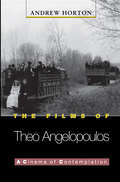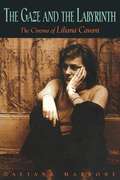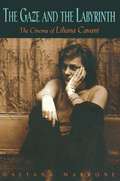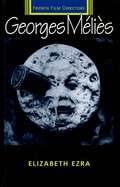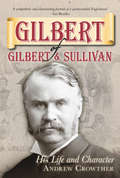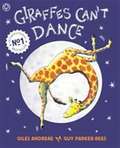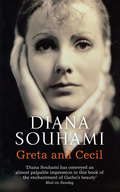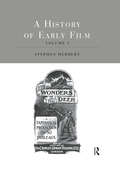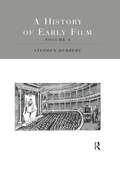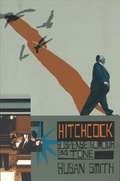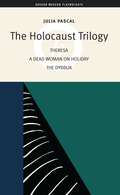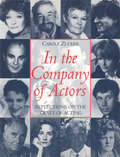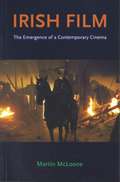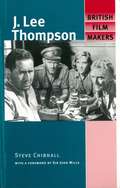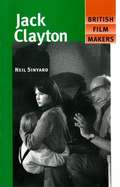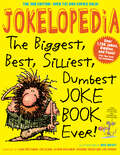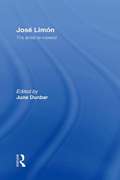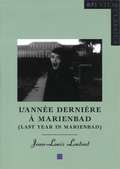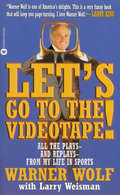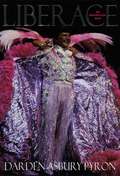- Table View
- List View
The Films of Theo Angelopoulos: A Cinema of Contemplation
by Andrew HortonGreek film director Theo Angelopoulos is one of the most influential and widely respected filmmakers in the world today, yet his films are still largely unknown to the American public. In the first book in English to focus on Angelopoulos's unique cinematic vision, Andrew Horton provides an illuminating contextual study that attempts to demonstrate the quintessentially Greek nature of the director's work. Horton situates the director in the context of over 3,000 years of Greek culture and history. Somewhat like Andrei Tarkovsky in Russia or Antonioni in Italy, Angelopoulos has used cinema to explore the history and individual identities of his culture. With such far-reaching influences as Greek myth, ancient tragedy and epic, Byzantine iconography and ceremony, Greek and Balkan history, modern Greek pop culture including bouzouki music, shadow puppet theater, and the Greek music hall tradition, Angelopoulos emerges as an original "thinker" with the camera, and a distinctive director who is bound to make a lasting contribution to the art form. In a series of films including The Travelling Players, Voyage to Cythera, Landscape in the Mist, The Suspended Step of the Stork, and most recently in Ulysses' Gaze starring Harvey Keitel (winner of the 1995 Cannes Film Festival Grand Prix), Angelopoulos has developed a remarkable cinematic style, characterized by carefully composed scenes and an enormous number of extended long shots. In an age of ever decreasing attention spans, Angelopoulos offers a cinema of contemplation.
The Gaze and the Labyrinth: The Cinema of Liliana Cavani
by Gaetana MarroneIn this, the first comprehensive book on Liliana Cavani, Gaetana Marrone redraws the map of postwar Italian cinema to make room for this extraordinary filmmaker, whose representations of transgressive eroticism, spiritual questing, and psychological extremes test the limits of the medium, pushing it into uncharted areas of discovery. Cavani's film The Night Porter (1974) created a sensation in the United States and Europe. But in many ways her critically renowned endeavors--which also include Francesco di Assisi, Galileo, I cannibali, Beyond Good and Evil, The Berlin Affair, and several operas and documentaries--remain enigmatic to audiences. Here Marrone presents Cavani's work as a cinema of ideas, showing how it takes pleasure in the telling of a story and ultimately revolts against all binding ideological and commercial codes. The author explores the rich visual language in which Cavani expresses thought, and the cultural icons that constitute her style and images. This approach affords powerful insights into the intricate interlacing of narrated events. We also come to understand the importance assigned to the gaze in the genesis of desire and the acquisition of knowledge. The films come to life in this book as the classical tragedies Cavani intended, where rebels and madmen experience conflict between historical and spiritual reality, the present and the past. Offering intertextual analyses within such fields as psychology, history, and cultural studies, along with production information gleaned from Cavani's personal archives, Marrone boldly advances our understanding of an intriguing, important body of cinematic work.
The Gaze and the Labyrinth: The Cinema of Liliana Cavani
by Gaetana MarroneIn this, the first comprehensive book on Liliana Cavani, Gaetana Marrone redraws the map of postwar Italian cinema to make room for this extraordinary filmmaker, whose representations of transgressive eroticism, spiritual questing, and psychological extremes test the limits of the medium, pushing it into uncharted areas of discovery. Cavani's film The Night Porter (1974) created a sensation in the United States and Europe. But in many ways her critically renowned endeavors--which also include Francesco di Assisi, Galileo, I cannibali, Beyond Good and Evil, The Berlin Affair, and several operas and documentaries--remain enigmatic to audiences. Here Marrone presents Cavani's work as a cinema of ideas, showing how it takes pleasure in the telling of a story and ultimately revolts against all binding ideological and commercial codes. The author explores the rich visual language in which Cavani expresses thought, and the cultural icons that constitute her style and images. This approach affords powerful insights into the intricate interlacing of narrated events. We also come to understand the importance assigned to the gaze in the genesis of desire and the acquisition of knowledge. The films come to life in this book as the classical tragedies Cavani intended, where rebels and madmen experience conflict between historical and spiritual reality, the present and the past. Offering intertextual analyses within such fields as psychology, history, and cultural studies, along with production information gleaned from Cavani's personal archives, Marrone boldly advances our understanding of an intriguing, important body of cinematic work.
Georges Melies (French Film Directors Series)
by Elizabeth EzraBefore the turn of the twentieth century, before the nickelodeon, even before the first cinemas, Georges Méliès began making movies.. Directing, editing, producing, designing, and starring in over 500 films between 1896 to 1912, Méliès was also the first cinematic auteur.. This is the first study of Méliès's films to appear in English in over twenty years and the only book to interpret his work using the tools of modern film analysis.. Locates the roots of modern narrative cinema in Méliès's work, identifying techniques of editing and mise-en-scène previously thought to have originated with D. W. Griffith.
Gilbert of Gilbert & Sullivan: His Life and Character (History Press Ser.)
by Andrew CrowtherThe author of The Pirates of Penzance, The Mikado, HMS Pinafore and the other great Savoy libretti, W S Gilbert, witty, caustic and disrespectful, was one of the celebrities of the late Victorian age. In his time he had been many things: journalist, theatre critic, cartoonist, comic poet, stage director, writer of short stories, dramatist. A political satire he wrote was banned by the Lord Chamberlain at the personal insistence of the Prince of Wales. He wrote the most brilliantly inventive plays of his time. With Arthur Sullivan he wrote comic operas that defined the age. He became richer and more famous than he could have imagined, but at the price of his artistic freedom. This is the story of an angry and quarrelsome man, discontented with himself and the age he lived in, raging at life’s absurdities and laughing at them. In this book his glorious, contradictory character is explored and brought vividly to life.
Giraffes Can't Dance (Orchard Picturebooks)
by Giles Andreae Guy Parker-ReesNumber One bestseller Giraffes Can't Dance from author Giles Andreae has been delighting children for over 15 years. Gerald the tall giraffe would love to join in with the other animals at the Jungle Dance, but everyone knows that giraffes can't dance . . . or can they? A funny, touching and triumphant picture book story about a giraffe who finds his own tune and confidence too, with joyful illustrations from Guy Parker Rees and a foiled cover.
Greta and Cecil (Phoenix Press Ser.)
by Diana SouhamiGreta Garbo first met society photographer Cecil Beaton in Hollywood in 1932. Both were caught in turbulent same-sex affairs. Yet Garbo flirted and danced with Beaton, told him he was pretty, presented him with 'a rose that lives and dies and never again returns' and at dawn drove away in her black Packard. Cecil took the rose home to England, framed it in silver and hung it above his bed. Fifteen years later Greta and Cecil met again. For her it was an idle flirtation. For him it fuelled his ambition to photograph her, to be like her and to marry her - an obsession that became a betrayal. Souhami draws on diaries, memoirs, letters, photographs and films to reveal the truth behind this fascinating and narcissistic relationship.
A History of Early Film V1
Volume 1 of A History of Early Film begins with the period of technical invention. The story of Edison's peepshow Kinetoscope, set up in arcades from April 1894, is told by W. K. L. Dickson. 'Lantern Projection of Moving Objects' heralds the arival of the first screenings in Britain, arranged by Auguste and Louis Lumière, Robert Paul and Birt Acres, announcing the new medium as a progressive development of optical moving-image toys, magic lantern projection and the Kinetoscope. It includes an evocative selection of advertisements for the earliest films and cinematographic apparatus of 1896-7. The last part of the volume covers 1901-6 as the medium of cinema developed.
A History of Early Film V3
Volume 3 of A History of Early Film examines critical responses to early cinema, including the impassioned thoughts of one of the first film critics, the American poet Vachel Lindsay and considers some contemporary judgements of the social aspects of moving pictures. The volume also includes the 1917 report The Cinema: Its Present Position and Future Possibilities...which provides a unique record of the attitudes towards the cinema by its British audiences exhibitors, producers, guardians of morality and those responsible for licensing.
Hitchcock: Suspense, Humour and Tone
by Susan SmithSusan Smith's treatment of the works of the most subtle of all film-makers analyses the key elements of suspense, humour and tone across the whole of the director's career. Arguing that all three are central to our viewing experience, the book demonstrates how Hitchcock's masterly integration of those elements is the key to his success as a film-maker.Examining in detail such films as Sabotage, Notorious, Rear Window, Psycho, Shadow of a Doubt, Rope and The Birds, amongst many others, the book discusses the idea of the director as saboteur and the importance of 'the avoidance of cliché' in Hitchcock's narrative.
The Holocaust Trilogy: The Dybbuk, Dead Woman On Holiday, Theresa (Oberon Modern Playwrights)
by Julia PascalIncludes the plays Theresa, A Dead Woman on Holiday and The DybbukPresented as a trilogy at the New End Theatre in 1995 before touring much of Europe, The Dybbuk pays homage to Anski’s great Russian classic. Set in a ghetto in Eastern Europe in 1942, it traces the final moments of five irreligious Jews. A Dead Woman on Holiday is a love story set during the Nuremberg trials. Theresa is based on secret research into the Channel Island occupation by the Nazis and the collaboration of the residents with the Holocaust. The play is still banned there.
In the Company of Actors: Reflections on the Craft of Acting
by Carole ZuckerIn the Company of Actors is a wonderful ensemble of entertaining and illuminating discussions with sixteen of the most celebrated and prestigious actors in contemporary theatre, film and television. The impressive list of actors includes: Eileen Atkins, Alan Bates, Simon Callow, Judi Dench, Brenda Fricker, Nigel Hawthorne, Jane Lapotaire, Janet McTeer, Ian Richardson, Miranda Richardson, Stephen Rea, Fiona Shaw, Anthony Sher, Janet Suzman, David Suchet, and Penelope Wilton. Carole Zucker covers a wide range of topics including the actors' main childhood influences, their actor training, early acting experience, preparation for roles and sound advice for coping with actors' problems such as creative differences with other actors or directors.
In the Company of Actors: Reflections on the Craft of Acting (Stage And Costume Ser.)
by Carole ZuckerIn the Company of Actors is a wonderful ensemble of entertaining and illuminating discussions with sixteen of the most celebrated and prestigious actors in contemporary theatre, film and television. The impressive list of actors includes: Eileen Atkins, Alan Bates, Simon Callow, Judi Dench, Brenda Fricker, Nigel Hawthorne, Jane Lapotaire, Janet McTeer, Ian Richardson, Miranda Richardson, Stephen Rea, Fiona Shaw, Anthony Sher, Janet Suzman, David Suchet, and Penelope Wilton. Carole Zucker covers a wide range of topics including the actors' main childhood influences, their actor training, early acting experience, preparation for roles and sound advice for coping with actors' problems such as creative differences with other actors or directors.
Irish Film: The Emergence of a Contemporary Cinema
by Martin McLooneThis is an exploration of the representation of Ireland and the Irish in British and US cinemas, as well as Irish-made films. The book offers readings of a wide range of key films such as The Butcher Boy (1997), Patriot Games (1992) and Angela's Ashes (1999). It discusses the full range of Irish cinematic productions from the low-budget work of Comerford and Breathnach, to the bigger Hollywood productions like Ron Howard's Far and Away (1992), and looks at the 'second' cinema of directors such as Neil Jordan and Jim Sheridan where medium-sized budgets allow for greater creative control in Ireland. Feeding into wider debates about national and cultural identity, post-national cinema and the role of the state, the book provides an overview of how a relatively small film culture such as Ireland's can live successfully in the shadow of Hollywood.
J. Lee Thompson (British Film-Makers)
by Steve ChibnallFirst published on the fiftieth anniversary of his directorial debut, this book was the first to examine the work of a man once hailed as the finest film-maker to emerge from the British studio system after the Second World War. Before being recruited by Hollywood, J. Lee Thompson made a string of classic films including: Yield to the Night (1956), Ice Cold in Alex (1958), Tiger Bay (1959), North West Frontier (1959) and The Guns of Navarone (1961). He worked in the Hollywood industry into his late eighties, making nearly thirty films as a director and producer between 1960 and 1990. He remains best known, however, for his first: the immortal thriller Cape Fear (1962). Drawing on extensive interview material, Steve Chibnall traces Lee Thompson's career in British cinema, and offers an analysis of his films which reveals remarkable, and previously unacknowledged, continuities of style and theme. This is a book for anyone interested in the history of British cinema, and particularly those who enjoy the best of 1950s and 1960s film.
Jack Clayton (British Film-Makers)
by Neil SinyardIn François Truffaut’s opinion The Innocents was ‘the best English film after Hitchcock goes to America’. Tennessee Williams said of The Great Gatsby: ‘a film whose artistry even surpassed the original novel’. The maker of both films was Jack Clayton, one of the finest English directors of the post-war era and perhaps best remembered for the trail-blazing Room at the Top which brought a new sexual frankness and social realism to the British screen. This is the first full-length critical study of Clayton's work. The author has been able to consult and quote from the director's own private papers which illuminate Clayton’s creative practices and artistic intentions. In addition to fresh analyses of the individual films, the book contains new material on Clayton's many unrealised projects and valuably includes his previously unpublished short story ‘The Enchantment’ – as poignant and revealing as the films themselves. This is a personal and fascinating account of the career and achievement of an important, much-loved director that should appeal to students and film enthusiasts.
Jean Renoir (French Film Directors Series)
by Martin O'ShaughnessyAccessible and original analysis of all Jean Renoir's sound films, including those he made in Hollywood - this is the first major study to appear for a number of years and brings new light on some of the director's most celebrated films.. Illuminating account of critical debates concerning Renoir, and focusing on hitherto neglected areas such as gender, nation and ethnicity the book asks us to rethink our understanding of Renoir's political commitment.. Traces his output from the silent period to the age of television, tying his work into a fast-shifting, socio-historical context.. Detailed analyses of his sound films map his evolving style while individual chapters cover Renoir's career and writings, critical debates, the silent and early sound films, the Popular Front period, Renoir amèricain and the later films.
Jokelopedia: The Biggest, Best, Silliest, Dumbest Joke Book Ever!
by Eva Blank Alison Benjamin Rosanne Green Ilana Weitzman Lisa SparksIt&’s the mother of all kids&’ joke books—an all-encompassing, gut-busting, and bestselling collection of more than 1,700 jokes, tongue-twisters, riddles, and puns for all occasions. Here are 61 elephant jokes, including: What did the elephant say when he walked into the post office? / Ouch! Dozens of knock-knock jokes, like: Knock-knock. / Who&’s there? / Doris. / Doris who? / Doris locked. That&’s why I knocked! Plus teacher jokes and creature jokes, doctor jokes and robber jokes, food jokes, gross jokes, why-did-the-chicken-cross-the-road jokes, and name-game jokes: What do you call a man in a tiger&’s cage? / Claude. And for all aspiring comedians, there are joke-telling pointers and tips, funny facts, and spotlights on comic TV shows, books, and actors, from Steve Carell to Tina Fey to SpongeBob Squarepants. It&’s the ultimate gift for the incurable jokester.
Jose Limon: An Artist Re-viewed (Choreography and Dance Studies Series)
by June DunbarJose Limn is universally recognized as one of the most important modern dancers of the 20th century. His technique is still taught at major colleges and dance schools; his dance company continues to revive his works, plus presents new works. His most famous work, The Moor's Pavanne, has been presented around the world by ballet and modern dance companies. This book presents a series of essays about Limn's life and works by noted scholars and dancers who were associated with Limn. It serves as a perfect introduction to his choreography and legacy. The book should appeal to fans of modern dance.
Jose Limon: An Artist Re-viewed (Choreography and Dance Studies Series)
by June DunbarJose Limn is universally recognized as one of the most important modern dancers of the 20th century. His technique is still taught at major colleges and dance schools; his dance company continues to revive his works, plus presents new works. His most famous work, The Moor's Pavanne, has been presented around the world by ballet and modern dance companies. This book presents a series of essays about Limn's life and works by noted scholars and dancers who were associated with Limn. It serves as a perfect introduction to his choreography and legacy. The book should appeal to fans of modern dance.
L'Année dernière à Marienbad (BFI Film Classics)
by Jean-Louis LeutratA quintessential work of 1960s European art cinema, L'Année dernière à Marienbad (Last Year in Marienbad, 1961) was a collaboration between director Alain Resnais and 'New Novel' enfant terrible Alain Robbe-Grillet. Three people, known only by their initials, move through the sprawling luxury of a mysterious hotel and its ornamental gardens. Perhaps M is A's husband and X her lover. Perhaps, 'last year', A promised X she would leave with him. Or is there something more terrible in the past? An abstract thriller, a love story, a philosophical puzzle, 'the film's deviations are', for Jean-Louis Leutrat, 'as complex as those of the human heart'.
Let's Go to the Videotape: All the Plays and Replays from My Life in Sports
by Larry Weisman Warner WolfAnyone who follows sports knows that Warner Wolf has revolutionized that world with his famous catch phrases and irrepressible spirit. Now, in "Let's Go to the Videotape!" he shares over three decades worth of humorous and unusual anecdotes from a fascinating career, including: -- opinions on sports rules -- game strategies that make no sense -- run-ins with the stars of sports and Hollywood -- including Shaquille O'Neal, Joe DiMaggio, Robert Redford, and Robert Duvall -- adventures and misadventures in the sports broadcasting game -- and much more.
Liberace: An American Boy
by Darden Asbury PyronMore people watched his nationally syndicated television show between 1953 and 1955 than followed I Love Lucy. Even a decade after his death, the attendance records he set at Madison Square Garden, the Hollywood Bowl, and Radio City Music Hall still stand. Arguably the most popular entertainer of the twentieth century, this very public figure nonetheless kept more than a few secrets. Darden Asbury Pyron, author of the acclaimed and bestselling Southern Daughter: The Life of Margaret Mitchell, leads us through the life of America's foremost showman with his fresh, provocative, and definitive portrait of Liberace, an American boy. Liberace's career follows the trajectory of the classic American dream. Born in the Midwest to Polish-Italian immigrant parents, he was a child prodigy who, by the age of twenty, had performed with the Chicago Symphony Orchestra. Abandoning the concert stage for the lucrative and glittery world of nightclubs, celebrities, and television, Liberace became America's most popular entertainer. While wildly successful and good natured outwardly, Liberace, Pyron reveals, was a complicated man whose political, social, and religious conservativism existed side-by-side with a lifetime of secretive homosexuality. Even so, his swishy persona belied an inner life of ferocious aggression and ambition. Pyron relates this private man to his public persona and places this remarkable life in the rapidly changing cultural landscape of twentieth-century America. Pyron presents Liberace's life as a metaphor, for both good and ill, of American culture, with its shopping malls and insatiable hunger for celebrity. In this fascinating biography, Pyron complicates and celebrates our image of the man for whom the streets were paved with gold lamé. "An entertaining and rewarding biography of the pianist and entertainer whose fans' adoration was equaled only by his critics' loathing. . . . [Pyron] persuasively argues that Liberace, thoroughly and rigorously trained, was a genuine musician as well as a brilliant showman. . . . [A]n immensely entertaining story that should be fascinating and pleasurable to anyone with an interest in American popular culture."—Kirkus Reviews "This is a wonderful book, what biography ought to be and so seldom is."—Kathryn Hughes, Daily Telegraph "[A]bsorbing and insightful. . . . Pyron's interests are far-ranging and illuminating-from the influence of a Roman Catholic sensibility on Liberace and gay culture to the aesthetics of television and the social importance of self-improvement books in the 1950s. Finally, he achieves what many readers might consider impossible: a persuasive case for Liberace's life and times as the embodiment of an important cultural moment."—Publishers Weekly "Liberace, coming on top of his amazing life of Margaret Mitchell, Southern Daughter, puts Darden Pyron in the very first rank of American biographers. His books are as exciting as the lives of his subjects."—Tom Wolfe "Fascinating, thoughtful, exhaustive, and well-written, this book will serve as the standard biography of a complex icon of American popular culture."—Library Journal
Liberace: An American Boy
by Darden Asbury PyronMore people watched his nationally syndicated television show between 1953 and 1955 than followed I Love Lucy. Even a decade after his death, the attendance records he set at Madison Square Garden, the Hollywood Bowl, and Radio City Music Hall still stand. Arguably the most popular entertainer of the twentieth century, this very public figure nonetheless kept more than a few secrets. Darden Asbury Pyron, author of the acclaimed and bestselling Southern Daughter: The Life of Margaret Mitchell, leads us through the life of America's foremost showman with his fresh, provocative, and definitive portrait of Liberace, an American boy. Liberace's career follows the trajectory of the classic American dream. Born in the Midwest to Polish-Italian immigrant parents, he was a child prodigy who, by the age of twenty, had performed with the Chicago Symphony Orchestra. Abandoning the concert stage for the lucrative and glittery world of nightclubs, celebrities, and television, Liberace became America's most popular entertainer. While wildly successful and good natured outwardly, Liberace, Pyron reveals, was a complicated man whose political, social, and religious conservativism existed side-by-side with a lifetime of secretive homosexuality. Even so, his swishy persona belied an inner life of ferocious aggression and ambition. Pyron relates this private man to his public persona and places this remarkable life in the rapidly changing cultural landscape of twentieth-century America. Pyron presents Liberace's life as a metaphor, for both good and ill, of American culture, with its shopping malls and insatiable hunger for celebrity. In this fascinating biography, Pyron complicates and celebrates our image of the man for whom the streets were paved with gold lamé. "An entertaining and rewarding biography of the pianist and entertainer whose fans' adoration was equaled only by his critics' loathing. . . . [Pyron] persuasively argues that Liberace, thoroughly and rigorously trained, was a genuine musician as well as a brilliant showman. . . . [A]n immensely entertaining story that should be fascinating and pleasurable to anyone with an interest in American popular culture."—Kirkus Reviews "This is a wonderful book, what biography ought to be and so seldom is."—Kathryn Hughes, Daily Telegraph "[A]bsorbing and insightful. . . . Pyron's interests are far-ranging and illuminating-from the influence of a Roman Catholic sensibility on Liberace and gay culture to the aesthetics of television and the social importance of self-improvement books in the 1950s. Finally, he achieves what many readers might consider impossible: a persuasive case for Liberace's life and times as the embodiment of an important cultural moment."—Publishers Weekly "Liberace, coming on top of his amazing life of Margaret Mitchell, Southern Daughter, puts Darden Pyron in the very first rank of American biographers. His books are as exciting as the lives of his subjects."—Tom Wolfe "Fascinating, thoughtful, exhaustive, and well-written, this book will serve as the standard biography of a complex icon of American popular culture."—Library Journal
Liberace: An American Boy
by Darden Asbury PyronMore people watched his nationally syndicated television show between 1953 and 1955 than followed I Love Lucy. Even a decade after his death, the attendance records he set at Madison Square Garden, the Hollywood Bowl, and Radio City Music Hall still stand. Arguably the most popular entertainer of the twentieth century, this very public figure nonetheless kept more than a few secrets. Darden Asbury Pyron, author of the acclaimed and bestselling Southern Daughter: The Life of Margaret Mitchell, leads us through the life of America's foremost showman with his fresh, provocative, and definitive portrait of Liberace, an American boy. Liberace's career follows the trajectory of the classic American dream. Born in the Midwest to Polish-Italian immigrant parents, he was a child prodigy who, by the age of twenty, had performed with the Chicago Symphony Orchestra. Abandoning the concert stage for the lucrative and glittery world of nightclubs, celebrities, and television, Liberace became America's most popular entertainer. While wildly successful and good natured outwardly, Liberace, Pyron reveals, was a complicated man whose political, social, and religious conservativism existed side-by-side with a lifetime of secretive homosexuality. Even so, his swishy persona belied an inner life of ferocious aggression and ambition. Pyron relates this private man to his public persona and places this remarkable life in the rapidly changing cultural landscape of twentieth-century America. Pyron presents Liberace's life as a metaphor, for both good and ill, of American culture, with its shopping malls and insatiable hunger for celebrity. In this fascinating biography, Pyron complicates and celebrates our image of the man for whom the streets were paved with gold lamé. "An entertaining and rewarding biography of the pianist and entertainer whose fans' adoration was equaled only by his critics' loathing. . . . [Pyron] persuasively argues that Liberace, thoroughly and rigorously trained, was a genuine musician as well as a brilliant showman. . . . [A]n immensely entertaining story that should be fascinating and pleasurable to anyone with an interest in American popular culture."—Kirkus Reviews "This is a wonderful book, what biography ought to be and so seldom is."—Kathryn Hughes, Daily Telegraph "[A]bsorbing and insightful. . . . Pyron's interests are far-ranging and illuminating-from the influence of a Roman Catholic sensibility on Liberace and gay culture to the aesthetics of television and the social importance of self-improvement books in the 1950s. Finally, he achieves what many readers might consider impossible: a persuasive case for Liberace's life and times as the embodiment of an important cultural moment."—Publishers Weekly "Liberace, coming on top of his amazing life of Margaret Mitchell, Southern Daughter, puts Darden Pyron in the very first rank of American biographers. His books are as exciting as the lives of his subjects."—Tom Wolfe "Fascinating, thoughtful, exhaustive, and well-written, this book will serve as the standard biography of a complex icon of American popular culture."—Library Journal
